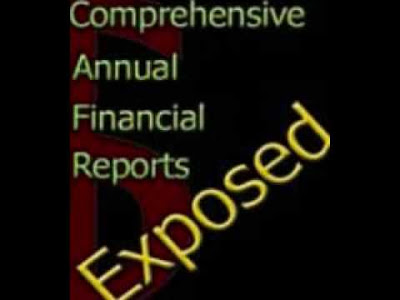CAFRs, the little publicized report
Its especially pleasing and productive when we are also able to act as a conduit for key national or community issues and are then better equipped to back up all your interests and aspirations.
The CAFR issue is very poignant and well addressed by Nigel. It merits its own article, which we issue in tribute to his own thoughtful community work.

 One World of Nations
One World of Nations
By Nigel, 3 August 2013
Most government bodies (city, county, state) are required by federal law to compile and submit to the Government Financial Officers Association a Comprehensive Annual Financial Report (CAFR). These little publicized reports can reveal a significantly different financial picture than more commonly used budgets. The CAFR is for the previous year of actuals rather than future plans. Walter Burien at www.cafr1.com presents the case that California and almost all states are over funded.
To expand on that, the CAFR can best be viewed as a balance sheet much like that which corporations issue, listing all assets and liabilities. It is required by federal law that a CAFR be issued annually by ALL government entities: Federal, state, county, city, US Postal Service, Social Security Administration, Retirement plans, etc. You get the idea. There is a large number of CAFRs issued each year, perhaps approaching 20,000; maybe many more. While CAFRs are not hidden, they are not publicized. Rather, the discussions of the finances of a government entity center on its budget, which is just a presentation of annual revenues from taxes and fees, as well as expenses for the year. The financial picture presented by these two documents is quite different.
It is a lot of work to review a CAFR and come away with a complete understanding. For example, the CAFR for the State of California is about 300 pages! Fortunately, Clint Richardson has done a lot of the work for us. His overview (published on his blog on 5/25/2012) of California's CAFR can be read here:
http://realitybloger.wordpress.com/2012/05/25/california-government-hides-billions-from-taxpayers/
It is very clear that Clint is a political activist and has a clear agenda. However, don't let his rhetoric get it the way of your careful consideration of the facts that he presents.
A bit later (July 21, 2012), Clint published a piece on his blog about CalPERS:
http://realitybloger.wordpress.com/2012/07/21/california-fools-californians-into-higher-taxes-again/
Two things jumped out at me:
1) "In fact, if CalPERS liquidated all of its investments today at today’s market value it could easily pay future pension benefits for the next 15-20 years." It doesn't look underfunded to me.
2) "Also notice that for the last 20 years, this fund has attained an above average return on investments, 7.7% compared to the desired 7.5%. This is the wonderful aspect of the CAFR – it allows you to see previous cycles so as to not be fooled by media sound bites. Here, CalPER’s confirms the data in the financial statements that prove that this fund is wealthy beyond even the stated CalPER’s long term goals."
For those of you that have the interest and the time and strength (vitamins and other nutritional supplements recommended), I suggest viewing Clint's YouTube presentation, in which he touches on CAFRs from government entities on many of the states:
It is lengthy at nearly 4 hours. However, for this and many YouTube videos you can select a faster or slower speed. If you are a fast listener (as I am), you can reduce the time from 4 hours to 2 hours and 40 minutes. When the video is playing, click on the "gear" icon on the lower right. Then select 1.5x from the right column of the small pop-up window. You'll get used to the faster speed in a short time and save 1/3 of the listening time.
As noted above, please ignore Clint's rhetoric; the facts speak volumes on their own. No need to throw out the baby with the bath water.
Here are some time markers for sections that I found interesting:
1) 1:38:45 - 1:56:40 - New York State's RE investments
2) 2:36:54 - 2:42:08 - CalPERS stock ownership
3) 2:42:08 - 2:51:53 - CalPERS
4) 3:35:09 - 3:40:25 - US Postal Service
5) 3:40:25 - 3:47:30 - Social Security
6) 3:47:30 - 3:54:43 - Conclusion
Posted by canauzzie at 2:00 am
Thanks to: http://canauzzie.blogspot.com
Its especially pleasing and productive when we are also able to act as a conduit for key national or community issues and are then better equipped to back up all your interests and aspirations.
The CAFR issue is very poignant and well addressed by Nigel. It merits its own article, which we issue in tribute to his own thoughtful community work.

 One World of Nations
One World of NationsBy Nigel, 3 August 2013
Most government bodies (city, county, state) are required by federal law to compile and submit to the Government Financial Officers Association a Comprehensive Annual Financial Report (CAFR). These little publicized reports can reveal a significantly different financial picture than more commonly used budgets. The CAFR is for the previous year of actuals rather than future plans. Walter Burien at www.cafr1.com presents the case that California and almost all states are over funded.
 |
| Walter Burien |
It is a lot of work to review a CAFR and come away with a complete understanding. For example, the CAFR for the State of California is about 300 pages! Fortunately, Clint Richardson has done a lot of the work for us. His overview (published on his blog on 5/25/2012) of California's CAFR can be read here:
http://realitybloger.wordpress.com/2012/05/25/california-government-hides-billions-from-taxpayers/
It is very clear that Clint is a political activist and has a clear agenda. However, don't let his rhetoric get it the way of your careful consideration of the facts that he presents.
A bit later (July 21, 2012), Clint published a piece on his blog about CalPERS:
http://realitybloger.wordpress.com/2012/07/21/california-fools-californians-into-higher-taxes-again/
Two things jumped out at me:
1) "In fact, if CalPERS liquidated all of its investments today at today’s market value it could easily pay future pension benefits for the next 15-20 years." It doesn't look underfunded to me.
2) "Also notice that for the last 20 years, this fund has attained an above average return on investments, 7.7% compared to the desired 7.5%. This is the wonderful aspect of the CAFR – it allows you to see previous cycles so as to not be fooled by media sound bites. Here, CalPER’s confirms the data in the financial statements that prove that this fund is wealthy beyond even the stated CalPER’s long term goals."
For those of you that have the interest and the time and strength (vitamins and other nutritional supplements recommended), I suggest viewing Clint's YouTube presentation, in which he touches on CAFRs from government entities on many of the states:
It is lengthy at nearly 4 hours. However, for this and many YouTube videos you can select a faster or slower speed. If you are a fast listener (as I am), you can reduce the time from 4 hours to 2 hours and 40 minutes. When the video is playing, click on the "gear" icon on the lower right. Then select 1.5x from the right column of the small pop-up window. You'll get used to the faster speed in a short time and save 1/3 of the listening time.
As noted above, please ignore Clint's rhetoric; the facts speak volumes on their own. No need to throw out the baby with the bath water.
Here are some time markers for sections that I found interesting:
1) 1:38:45 - 1:56:40 - New York State's RE investments
2) 2:36:54 - 2:42:08 - CalPERS stock ownership
3) 2:42:08 - 2:51:53 - CalPERS
4) 3:35:09 - 3:40:25 - US Postal Service
5) 3:40:25 - 3:47:30 - Social Security
6) 3:47:30 - 3:54:43 - Conclusion
Posted by canauzzie at 2:00 am
Thanks to: http://canauzzie.blogspot.com






 Sat Mar 23, 2024 11:33 pm by globalturbo
Sat Mar 23, 2024 11:33 pm by globalturbo

